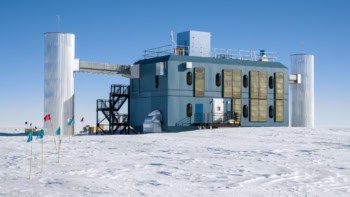
The interaction between an electron and a calcium-40 nucleus has been calculated from first principles for the first time. Physicists in Germany and the US led by Joanna Sobczyk, Sonia Bacca and Bijaya Acharya at Johannes Gutenberg University Mainz used “chiral effective field theory” to account for the complex interactions that occur when an electron scatters from calcium-40 nuclei and validated their model using data from experiments.
One of the most important goals of nuclear physics is to predict the observed properties of atomic nuclei based purely on how many protons and neutrons they contain – something that has proven elusive for all but the simplest of nuclei. One property of interest is how nuclei interact with much less massive particles called leptons, which include electrons and neutrinos.
Sobczyk and colleagues are particularly interested in learning more about how neutrinos interact with nuclei, because this information could be used to devise better neutrino experiments. Because neutrinos have no electrical charge, they do not interact with nuclei that often and therefore there is not much experimental data to hone theoretical models.
Instead, Sobczyk’s team has focussed on how the electron interacts with nuclei – which can then be generalized for all leptons. They calculated how a single electron interacts with a calcium-40 using the underlying principles of “chiral effective field theories” – which describe the forces imparted and experienced by individual protons and neutrons in a nucleus.
Too many protons and neutrons
Previously, there were just too many protons and neutrons in a nucleus size of calcium-40 for such a calculation to be done. In their new theoretical approach, the researchers calculated the “longitudinal response function” of calcium-40, which is the probability that an electron will be deflected at a certain angle when it enters the vicinity of the nucleus.
When comparing their calculations with observations from real scattering experiments, Sobczyk and colleagues found that they were in close agreement with each other in cases where the electron and nucleus exchanged a low or intermediate amount of momentum. The technique also allowed them to rigorously quantify any uncertainties in their calculations – which is typically an extremely time-consuming process.

Electron interaction with heavy nucleus calculated from first principles
The team believes that its approach represents a key milestone towards first-principles calculations of neutrino-nucleus interactions. In the future it could provide guidance for those building neutrino detectors, which search for extremely subtle signals of interaction between neutrinos and matter. Their methods could also shed new light on the poorly-understood effect of “neutrino oscillation” – where the particles spontaneously transform between three different neutrino flavours.
For now, the team aims to carry out first-principles calculations of argon nuclei which will be used as a detector target in the upcoming Deep Underground Neutrino Experiment (DUNE) in the US. This experiment will be jointly done by Fermilab and the Sanford Underground Research Facility.
The research is described in Physical Review Letters.



